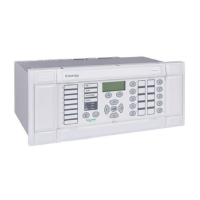P54x/EN MR/La4 Measurements and Recording
(MR) 8-4
MiCOM P543, P544, P545 & P546
MR
For extraction from a remote source via communications, refer to the SCADA
Communications chapter (P54x/EN SC), where the procedure is fully explained.
1.2.1 Types of event
An event ma
y be a change of state of a control input or output relay, an alarm condition,
setting change etc. The following sections show the various items that constitute an event:
1.2.1.1 Change of state of opto-isolated inputs
If one or more of the opto (logi
c) inputs has changed state since the last time that the
protection algorithm ran, the new status is logged as an event. When this event is selected
to be viewed on the LCD, three applicable cells will become visible as shown below:
Time & date of event
“LOGIC INPUTS 1”
“Event Value 0101010101010101”
The Event Value is an 8, 12, 16 or 24-bit word showing the status of the opto inputs, where
the least significant bit (extreme right) corresponds to opto input 1 etc. The same
information is present if the event is extracted and viewed via PC.
1.2.1.2 Change of state of one or more output relay contacts
If one or mo
re of the output relay contacts have changed state since the last time that the
protection algorithm ran, then the new status is logged as an event. When this event is
selected to be viewed on the LCD, three applicable cells will become visible as shown below:
Time & date of event
“OUTPUT CONTACTS 1”
“Event Value 010101010101010101010”
The Event Value is an 8, 12, 16, 24 or 32 bit word showing the status of the output contacts,
where the least significant bit (extreme right) corresponds to output contact 1 etc. The same
information is present if the event is extracted and viewed via PC.
1.2.1.3 Relay alarm conditions
Any alarm conditions generated by the relays will al
so be logged as individual events. The
following table shows examples of some of the alarm conditions and how they appear in the
event list:
Alarm condition Event text Event value
Battery Fail Battery Fail ON/OFF Bit position 0 in 32 bit field
Field Voltage Fail Field Volt Fail ON/OFF Bit position 1 in 32 bit field
Setting Group via Opto
Invalid
Setting Grp. Invalid ON/OFF Bit position 2 in 32 bit field
Protection Disabled Prot’n. Disabled ON/OFF Bit position 3 in 32 bit field
Frequency out of Range Freq. out of Range ON/OFF Bit position 4 in 32 bit field
VTS Alarm VT Fail Alarm ON/OFF Bit position 5 in 32 bit field
CB Trip Fail Protection CB Fail ON/OFF Bit position 7 in 32 bit field
The previous table shows the abbreviated description that is given to the various alarm
conditions and also a corresponding value between 0 and 31. This value is appended to
each alarm event in a similar way as for the input and output events previously described. It
is used by the event extraction software, such as MiCOM S1, to identify the alarm and is
therefore invisible if the event is viewed on the LCD. Either ON or OFF is shown after the
description to signify whether the particular condition has become operated or has reset.

